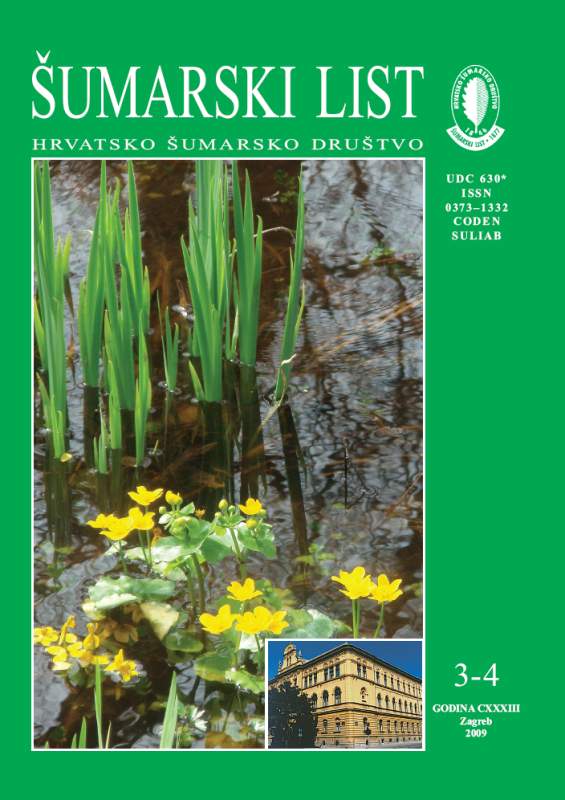
broj: 3-4/2009
pdf (5,7 MB) |
|
||||||||||||||
| RIJEČ GLAVNOGA UREDNIKA | ||
| Branimir Prpić | ||
| ON THE RELATIONSHIP BETWEEN FORESTRY AND OFFICIAL NATURE PROTECTION pdf HR EN | 120 | |
| Together with Mr. P. Jurjević, MSc, President of the Croatian Forestry Association, I attended a sector meeting of theforestry workshop held on April 1, 2009. The meeting was organized by the State Institute for Nature Protectionwith thepurpose of discussing a consulting process for the Natura 2000 Ecological Network in Croatia. To start with, I was astonished not to see any forestry experts among the Institute’s representatives, despite the factthat, until recently, the Institute had always been headed by forestry professionals (Kevo, Šobat, Meštrović, Mihanić). Thebasic phenomenon in the majority of the Croatian national parks and nature parks is a forest: therefore, it is surprisingthat the workshop was not run by a forester working in the State Institute for Nature Protection, if indeed there are anyforesters employed by the Institute. The forestry science marches on, and the entire discussion on Natura 2000 would certainly have had a different coursehad it been chaired by an experienced forest silviculturalist, ecologist or protector. This was particularly evident whenProfessor Vukelić took the stand:his team had completed their part of work around the National Ecological Networkexceptionally professionally. Through the Croatian Forestry Association, the forestry science and profession have laid invaluable scientific andexpert foundations for an efficient management with Croatian forests according to the principles of the Zagreb School ofSilviculture. Their work has resulted in the establishment of a naturally managed forest, which has a protective role in 95% of state-owned forests. This does not exist in Europe any more; thus, Croatian forests in fact represent sites of generalnature protection, something to take into account in protecting 20 % of large forest communities. We were apprehensive about the debates in the sector workshop concerning the prolongation of the rotation period. We ourselves had advocated this approach prior to the occurrence of the atmospheric glasshouse effect, but have sinceabandoned this idea since old forests are inefficient as carbon sinks.We were also puzzled by the report of the StateInstitute for Nature Protection on the “Current State of Nature and Nature Protection in Croatia”, issued for forestry (seein more detail: minutes of the 3rdmeeting of the Managing and Supervisory Board of the Croatian Forestry Association,“Forestry Journal” 11–12/2008, p. 589, paragraph. 2, written by the secretary Damir Delač, BSc.). Although forestry at the Faculty of Forestry in Zagreb is firmly based on a biologicalprogram of forest as an ecosystem and although foresters are undoubtedly the best educated persons to deal with forest nature protection, we still needbiologiststocomplement the structure of forest ecosystems in the sense of studying a part of animal and plant world, mycorrhiza and allelopathy. However,they can in no way give instructions on how to manage forests. This part of work shouldbe allocated to experienced silviculturalists, ecologists, foresters, phytocoenologists and forest protectors. An example of good cooperation is that with Dr. Jasminka Radović, a biologist who perceives forests as an exceptional natural wealth in Croatia. Professor Branimir Prpić, PhD | ||
| IZVORNI ZNANSTVENI ČLANCI | ||
| Topić,V., L. Butorac, Z. Đurđević, B. Kekelić, G. Jelić | UDK 630* 232.3 (001) Cupressus sempervirens var. pyramidalis Nyman | |
| Effect of Container Type on Growth and Developtment of Seedlings of Common Cypress (Cupressus sempervirens var. pyramidalis Nyman) in Nurseriers and Forest Cultures pdf HR EN | 121 | |
| Anić,I., J. Vukelić, S. Mikac, D. Bakšić, D. Ugarković | UDK 630* 181.2 (001) Abies alba Mill. | |
| Effects of Global Climate Change on the Ecological Niche of Silver Fir(Abies albaMill.) in Croatia pdf HR EN | 135 | |
| Klobučar,D., R. Pernar | UDK 630* 585 (001) | |
| Artificial Neural Networks in the Estimation of Stand Density from Cyclic Recordings pdf HR EN | 145 | |
| Pernek,M., D. Matošević | UDK 630* 453 (001) Obolodiplosis robiniae | |
| Black Locust Gall Midge(Obolodiplosis robiniae), New Pest on Black Locust Trees and first Record of ParasitoidPlatygaster robinaein Croatia pdf HR EN | 157 | |
| Butorac,L., V. Topić, G. Jelić | UDK 630* 116 + 434 (001) Pinus halepensis Mill. | |
| Sufrace Runoff and Soil Loss in Burnt Stands of Aleppo Pine(Pinus halepensisMill.) Growing on Colluvial Soils pdf HR EN | 165 | |
| Vuletić,D., S. Krajter, M. Mrazek,A. Ćorić | UDK 630* 652 + 289 (001) | |
| Non Wood Forest Products and Services – Are we Using them Enough? pdf HR EN | 173 | |
| Govorčin,S., T.Sinković, R. Hrčka | UDK 630* 812 + 813 (001) Fraxinus excelsior L. | |
| Some Physical and Mechanical Properties of Recent and Heat Treated Ash– Fraxinus Excelsior L. pdf HR EN | 185 | |
| ZNANSTVENI I STRUČNI SKUPOVI | ||
| Jakovac, Hranislav | ||
| Biological-Ekological and Energetic Characteristics of Indigobush (Amorpha fructicosaL.) in Croatia PDF | 202 | |


